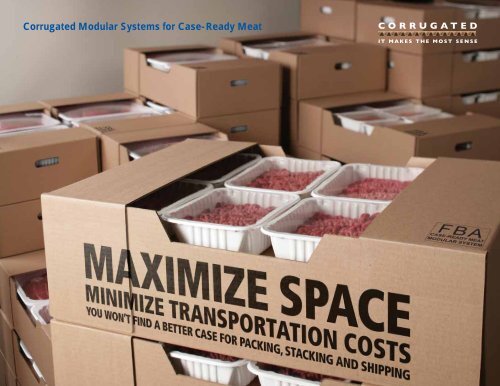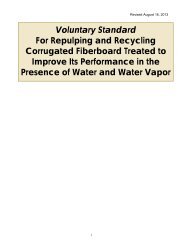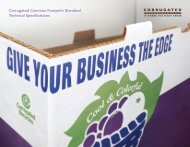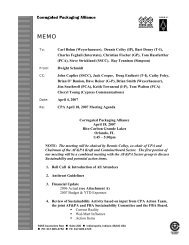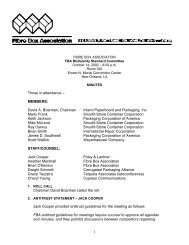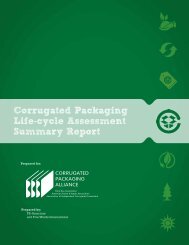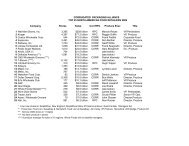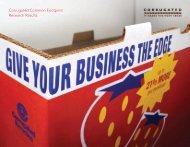Corrugated Modular Systems for Case-Ready Meat
Corrugated Modular Systems for Case-Ready Meat
Corrugated Modular Systems for Case-Ready Meat
Create successful ePaper yourself
Turn your PDF publications into a flip-book with our unique Google optimized e-Paper software.
<strong>Corrugated</strong> <strong>Modular</strong> <strong>Systems</strong> <strong>for</strong> <strong>Case</strong>-<strong>Ready</strong> <strong>Meat</strong>
Two footprints<br />
Fits standard pallets<br />
Maximizes payloads<br />
Minimizes costs<br />
Lighter tare weight<br />
Custom-design options<br />
Minimum internal dimensions<br />
★ ★ ★<br />
THE ADVANTAGES OF<br />
CORRUGATED<br />
PACKAGING<br />
STACK UP<br />
The corrugated packaging industry has designed new, voluntary<br />
modular systems <strong>for</strong> <strong>Case</strong>-<strong>Ready</strong> <strong>Meat</strong>. The corrugated modular<br />
packaging systems make shipping all <strong>Case</strong>-<strong>Ready</strong> <strong>Meat</strong> far<br />
more efficient than other containers.<br />
<strong>Ready</strong> to meet the future.<br />
For many retailers, <strong>Case</strong>-<strong>Ready</strong> is becoming the prominent shipping and<br />
merchandising <strong>for</strong>mat <strong>for</strong> meat and poultry. This <strong>Case</strong>-<strong>Ready</strong> <strong>Meat</strong> <strong>for</strong>mat<br />
represents an opportunity <strong>for</strong> new packaging solutions that optimize<br />
efficiency throughout the supply chain.<br />
New corrugated modular systems <strong>for</strong> <strong>Case</strong>-<strong>Ready</strong> <strong>Meat</strong>.<br />
A corrugated industry team coordinated by the Fibre Box Association (FBA)<br />
proactively developed the new modular systems <strong>for</strong> <strong>Case</strong>-<strong>Ready</strong> <strong>Meat</strong>. These<br />
solutions establish recommended, yet voluntary, uni<strong>for</strong>m transport package<br />
footprint dimensions that offer unmatched packaging and supply chain<br />
flexibility. These lighter-weight, retail-ready, packaging solutions reduce<br />
freight costs and significantly increase payload.<br />
The new voluntary systems permit corrugated <strong>Case</strong>-<strong>Ready</strong> <strong>Meat</strong> containers<br />
to efficiently travel from processor, to distribution centers, to retail locations.<br />
The result? A supply chain with increased speed, decreased distribution<br />
costs and more efficient package, pallet and trailer cube utilization.
System benefits.<br />
Benefits of the <strong>Case</strong>-<strong>Ready</strong> <strong>Meat</strong><br />
standard fixed footprints include:<br />
• More product can be shipped from<br />
more producers on the same trailer,<br />
at a lower cost per package and<br />
per pound<br />
• Further improves trailer cube efficiency<br />
by allowing the evolution of cubeoptimized<br />
primary tray solutions<br />
• Distribution centers can build solid,<br />
stable, full and mixed-unit loads of<br />
<strong>Case</strong>-<strong>Ready</strong> product from multiple<br />
producers<br />
• Better efficiency and less potential<br />
damage when building mixed protein<br />
pallets <strong>for</strong> redistribution to the store<br />
level<br />
• Easily adapts to new primary package<br />
sizes or merchandising requirements<br />
without sacrificing supply chain<br />
efficiencies<br />
• Greater payload efficiency and lower<br />
freight costs whether delivering to a<br />
distribution center or direct to store<br />
• Two solution offerings (parallel 5- and<br />
6-Down systems) provide benefits<br />
<strong>for</strong>, and accommodate, major retailer<br />
preferences as well as current and<br />
future/optimal primary trays<br />
• Design flexibility allows <strong>for</strong><br />
packaging customization<br />
<strong>Corrugated</strong> recycles.<br />
Since corrugated containers are<br />
recyclable, you can feel confident<br />
that by choosing corrugated you<br />
are protecting your precious cargo<br />
and the environment. More than<br />
75 percent of corrugated boxes<br />
are recycled, giving corrugated<br />
the highest recycling rate of any<br />
packaging material used today.<br />
Recycled corrugated containers<br />
are compliant with FDA standards.<br />
Additionally, ongoing research<br />
and development programs are<br />
continuously improving corrugated<br />
characteristics such as strengthto-weight<br />
ratio, printability, and<br />
recyclability.<br />
Parallel systems.<br />
Multiple benefits.<br />
The corrugated industry designed two<br />
footprint systems that offer advantages<br />
at every step in the distribution chain:<br />
5-Down and 6-Down. These two different<br />
footprints are offered to allow flexibility<br />
<strong>for</strong> accommodating primary tray sizes<br />
(which have yet to be standardized).<br />
This way, the supply chain can transition<br />
toward a modular standard with the<br />
lowest possible distribution costs.<br />
In addition, different types of protein<br />
suppliers may prefer a different (5- or 6-<br />
Down) solution depending on cuts, cube<br />
utilization, and the needs of their specific<br />
supply chain.<br />
IMPORTANT CORRUGATED<br />
MODULAR SYSTEM FACTS<br />
They do not specify<br />
strength values.<br />
The corrugated modular systems<br />
<strong>for</strong> <strong>Case</strong>-<strong>Ready</strong> <strong>Meat</strong> in<strong>for</strong>m the<br />
corrugated manufacturer and their<br />
customers of shared responsibility<br />
to incorporate container strength<br />
appropriate to the application and<br />
meat products being shipped. In<br />
the interest of optimization <strong>for</strong> each<br />
unique supply chain, they do not<br />
provide material specifications and/or<br />
compression/stacking strength value<br />
recommendations <strong>for</strong> containers.<br />
Strength requirements should be jointly<br />
evaluated between the purchaser<br />
and the corrugated supplier, recognizing<br />
that the containers may be shipped in<br />
mixed unit loads, potentially resulting<br />
in greater compression strength<br />
requirements than might be necessary<br />
when shipping homogenous unit loads.<br />
They allow <strong>for</strong> design flexibility.<br />
The voluntary corrugated modular<br />
systems <strong>for</strong> <strong>Case</strong>-<strong>Ready</strong> <strong>Meat</strong> allow <strong>for</strong><br />
design flexibility. The modular systems<br />
encourage container manufacturers to<br />
employ corrugated’s inherent design<br />
flexibility to ensure that meat products<br />
are packed in containers that suit<br />
each product’s needs. Compression,<br />
stacking and containment requirements<br />
are functions of the weight of the<br />
container contents, the structural<br />
design and fiber content of the<br />
corrugated and the distribution<br />
environment. Additionally, containerdesign<br />
features are not necessarily<br />
covered by these modular systems.<br />
The corrugated modular systems are<br />
not intended to preclude innovation<br />
in the design and per<strong>for</strong>mance of the<br />
corrugated container. Design options<br />
include but are not limited to:<br />
• Structural styles<br />
• Varying depths<br />
• Cooling/venting/opening features<br />
• Graphics<br />
• Interior and exterior colors<br />
• Manual and/or machine setups<br />
Flexible, industrious and efficient. When you want to go modular<br />
<strong>for</strong> <strong>Case</strong>-<strong>Ready</strong> <strong>Meat</strong>, the corrugated industry has the answer.
The <strong>Corrugated</strong> Packaging Alliance (www.corrugated.org) is a corrugated industry initiative jointly sponsored by the American Forest & Paper Association (AF&PA) (www.afandpa.org)<br />
and the Fibre Box Association (FBA) (www.fibrebox.org). Its mission is to foster growth and profitability of corrugated in applications where it can be demonstrated, based on credible<br />
and persuasive evidence, that corrugated should be the packaging material of choice; and to provide a coordinated industry focus that effectively acts on industry matters that cannot<br />
be accomplished by individual members.<br />
For details, ask your corrugated supplier or call the Fibre Box<br />
Association (FBA). FBA is a non-profit industry organization<br />
representing and serving the U.S. corrugated manufacturing<br />
industry. Its member companies produce over 90 percent of<br />
corrugated packaging manufactured in the United States.<br />
FBA also has members in Canada and Mexico.<br />
FBA<br />
2850 Golf Road<br />
Rolling Meadows, IL 60008 USA<br />
Phone: 847.364.9600<br />
Fax: 847.364.9639<br />
www.fibrebox.org<br />
800.886.5255 www.corrugated.org<br />
Union bug here<br />
This brochure is printed on 10% recovered fiber.


